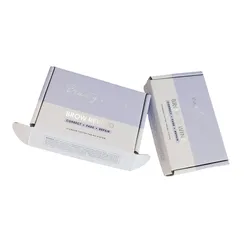Why Are Paper Boxes the Future of Sustainable Packaging?
2024-12-23
In recent years, the push for sustainability has gained significant momentum, especially in the packaging industry. One material that has been at the forefront of this movement is paper. Paper boxes, in particular, have emerged as a versatile, eco-friendly solution for packaging across industries. But why are paper boxes becoming the go-to choice for sustainable packaging, and how do they compare to traditional materials? In this blog, we’ll explore why paper boxes are increasingly seen as the future of sustainable packaging.
1. What Makes Paper Boxes Eco-Friendly?
Paper boxes are often praised for their environmental benefits. Here are some reasons why they stand out as an eco-friendly packaging solution:
- Renewable and Recyclable: Paper is a renewable resource that can be recycled multiple times. This reduces the need for new raw materials, cuts down on waste, and helps conserve natural resources. Additionally, paper boxes are widely accepted by recycling programs, making them easy to dispose of sustainably.
- Biodegradable: Unlike plastic packaging, which can take hundreds of years to decompose, paper boxes break down naturally in landfills. This makes them a better alternative for businesses and consumers looking to reduce their environmental footprint.
- Lower Carbon Footprint: The production of paper boxes typically generates fewer greenhouse gas emissions than plastic or glass alternatives. Many paper manufacturers are also transitioning to renewable energy sources to further reduce their carbon footprints.
2. How Do Paper Boxes Help in Reducing Plastic Waste?
Plastic pollution is one of the most pressing environmental challenges of our time. Paper boxes offer a powerful solution to reduce plastic waste, especially in sectors like food packaging, e-commerce, and retail.
- Alternatives to Plastic Packaging: Many businesses are switching from plastic packaging to paper-based alternatives. For example, fast-food chains are increasingly using paper boxes for takeout, while online retailers are replacing plastic mailers with paper packaging.
- E-Commerce Impact: As e-commerce continues to grow, so does the demand for packaging. Paper boxes are becoming a common choice for shipping, as they are lightweight, durable, and less harmful to the environment than plastic. Many companies, including giants like Amazon, are committing to using paper packaging in their shipments to reduce plastic waste.
3. Are Paper Boxes Strong and Durable Enough for All Products?
One of the common concerns with paper-based packaging is whether it can withstand the demands of shipping, storage, and handling. The answer is yes—modern paper boxes are both strong and durable enough for a wide range of applications.
- Customizable Strength: Paper boxes can be manufactured in different grades and thicknesses, making them suitable for a variety of products. For instance, corrugated paper boxes, which feature multiple layers of paper, provide excellent strength and cushioning for fragile items.
- Protection and Versatility: Paper boxes can be designed with specific features like reinforced corners, moisture barriers, and tamper-evident seals, ensuring that products are protected during transit and storage.
4. How Do Paper Boxes Support Branding and Marketing?
In addition to their environmental benefits, paper boxes also offer businesses an excellent opportunity for branding and marketing. Their versatility and printability make them an effective tool for creating a strong brand presence.
- Custom Printing: Paper boxes can be easily customized with logos, product information, and promotional messages. High-quality printing options, such as embossing, foil stamping, and spot UV coating, allow brands to create visually appealing packaging that resonates with consumers.
- Eco-Conscious Consumers: Many consumers today are prioritizing sustainability in their purchasing decisions. By using paper boxes, businesses can signal to their customers that they are committed to reducing their environmental impact, potentially attracting a loyal, eco-conscious customer base.
5. What Are the Challenges of Paper Box Packaging?
While paper boxes offer numerous benefits, there are a few challenges to consider:
- Moisture Sensitivity: Paper boxes can be susceptible to water damage, which may weaken their structural integrity. However, advancements in coatings and treatments are addressing this issue, making paper boxes more resistant to moisture.
- Transportation Costs: Because paper boxes are generally bulkier and less compact than plastic alternatives, transportation costs can be higher. However, this can be mitigated by optimizing packaging design to minimize unused space.
Conclusion
Paper boxes are rapidly becoming the future of sustainable packaging due to their environmental benefits, versatility, and growing demand. By opting for paper-based packaging, businesses can reduce their carbon footprint, minimize plastic waste, and appeal to environmentally conscious consumers. As technology advances and the recycling infrastructure improves, the role of paper boxes in sustainable packaging will only continue to grow.



